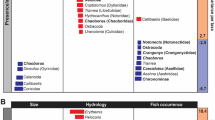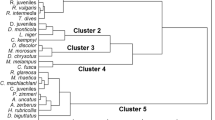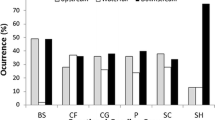Abstract
The influence of physical habitat variables and suspended particulate organic matter (seston) on the distribution and production of eight species of larval Hydropsychidae was studied along a 6.4 km section of a southern Appalachian stream. Samples were collected at six stations encompassing stream orders 1–4 and an elevation range of 610 m. Multivariate analysis of covariance (using time as the covariable) and discriminant function analysis were used to examine habitat differences between the sampling stations due to the following variables: current velocity; coarse benthic detritus; substrate composition (by particle size); substrate heterogeneity; degree-days; and diel temperature fluctuation. The associations of these variables with the abundance (and production) of larval hydropsychids was also examined using the same statistical procedures. The six sampling stations represented three or four distinct habitats based on patterns of change in the variables along the stream continuum. Diel temperature fluctuation, median substrate particle size, the proportion of sand substrate, and substrate heterogeneity were most closely associated with the overall difference between the sampling stations. Hydropsychid species distribution along the stream system followed subfamily lines, i.e., Arctopsychinae and Diplectroninae were more abundant and productive in the upper 4.5 km of the stream, while Hydropsychinae were dominant in the lower 1.9 km. Diel temperature fluctuation was the habitat variable most highly correlated with patterns of hydropsychid abundance and production. The longitudinal pattern of species distribution, i.e., larger particle feeding Arctopsychinae being replaced downstream by smaller particle feeding Hydropsychinae, also coincided with the distribution of seston particle size classes along the stream. Mean seston particle size generally declined downstream, as particles <42 µm increased in relative abundance while those between 43 µm and 5 mm decreased. Temperature, seston, and substrate composition all undoubtedly exerted an important influence on the distribution and production of Hydropsychidae and other filter feeding insects in this stream. The validity and generality of these results depend upon the scope of the sampling effort. Conclusions drawn from data collected over the entire range (and limits) of a species' distribution are more sound than those based on data from a limited area.
Similar content being viewed by others
References
Alstad, D. N., 1978. Distributional and community ecology of filtering caddisflies (Trichoptera: Hydropsychidae). Ph. D. dissertation, University of Utah, Salt Lake City. 87 pp.
Alstad, D. N., 1980. Comparative biology of the common Utah Hydropsychidae. Am. Midland Nat. 103: 167–174.
Anderson, N. H. & Cummins, K. W., 1979. Influence of diet on the life histories of aquatic insects. J. Fish. Res. Bd Can. 36: 335–342.
Anderson, S. H. & Shuggart, H. H., 1974. Habitat selection of breeding birds in an east Tennessee deciduous forest. Ecology 55: 828–837.
Benke, A. C. & Wallace, J. B., 1980. Trophic basis of production among net-spinning caddisflies in an southern Appalachian stream. Ecology 61: 108–118.
Boon, P. J., 1979. Studies on the spatial and temporal distribution of larval Hydropsychidae in the North Tyne River system, northern England (UK). Arch. Hydrobiol. 85: 336–359.
Boon, P. J. & Shires, S. W., 1976. Temperature studies on a river system in northeast England. Freshwat. Biol. 6: 23–32.
Colbo, M. H. & Porter, G. N., 1981. The interaction of rearing temperature and food supply on the life history of two species of Simuliidae (Diptera). Can. J. Zool. 59: 158–163.
Cummins, K. W., 1962. An evaluation of some techniques for the collection and analysis of benthic samples with special emphasis on lotic waters. Am. Midland Nat. 67: 477–504.
Cummins, K. W. & Lauff, G. W., 1969. The influence of substrate particle size on the micro-distribution of stream macrobenthos. Hydrobiologia 34: 145–181.
Edington, J. M., 1968. Habitat preferences in net-spinning caddis larvae with special reference to the influence of water velocity. J. Anim. Ecol. 37: 675–692.
Edington, J. M. & Hildrew, A. G., 1973. Experimental observations relating to the distribution of net-spinning Trichoptera in streams. Verh. int. Verein. Limnol. 18: 1549–1558.
Flint, O. S., 1961. Immature stages of the Arctopsychinae occurring in eastern North America. Ann. ent. Soc. Am. 54: 5–11.
Fuller, R. L. & Mackay, R. J., 1980a. Field and laboratory studies of net-spinning activity by Hydropsyche larvae (Trichoptera: Hydropsychidae). Can. J. Zool. 58: 2006–2014.
Fuller, R. L. & Mackay, R. J., 1980b. Feeding ecology of three species of Hydropsyche (Trichoptera: Hydropsychidae) in southern Ontario. Can. J. Zool. 58: 2239–2251.
Fuller, R. L. & Mackay, R. J., 1981. Effects of food quality on the growth of three Hydropsyche species (Trichoptera: Hydropsychidae). Can. J. Zool. 59: 1133–1140.
Georgian, T. J., Jr. & Wallace, J. B., 1981. A model of seston capture by net-spinning caddisflies. Oikos 36: 147–157.
Gessner, F., 1950. Hydrobotanik. I. Energiehaushalt. Deutsch Ver. Wissensch., Berlin. 517 pp.
Gleason, H. A., 1926. The individualistic concept of the plant association. Bull. Torrey bot. Club 53: 7–26.
Gordon, A. E. & Wallace, J. B., 1975. Distribution of the family Hydropsychidae in the Savannah River basin of North Carolina, South Carolina, and Georgia. Hydrobiologia 46: 405–423.
Gose, K., 1970. Life history and instar analysis of Stenopsyche griseipennis (Trichoptera). Jap. J. Limnol 31: 96–106.
Green, R. H., 1971. A multivariate statistical approach to the Hutchinsonian niche: bivalve molluscs of central Canada. Ecology 52: 543–556.
Green, R. H., 1974. Multivariate niche analysis with temporally varying environmental factors. Ecology 55: 73–83.
Haefner, J. D. & Wallace, J. B., 1981. Production and potential seston utilization of Parapsyche cardis and Diplectrona modesta (Trichoptera: Hydropsychidae) in two streams draining contrasting southern Appalachian watersheds. Environ. Ent. 10: 433–441.
Harris, S. C. & Carlson, R. B., 1978. Distribution of Hydropsychidae (Trichoptera) in the sandhill streams of southeastern North Dakota. Ann. Proc. N. Dakota Acad. Sci. 31: 23–27.
Hildrew, A. G., 1977. Ecological aspects of life history in some net-spinning Trichoptera. In: Proc. 2nd Int. Symp. on Trichoptera, pp. 269–281. Junk, The Hague.
Hildrew, A. G. & Edington, J. M., 1979. Factors facilitating the coexistence of hydropsychid caddis larvae (Trichoptera) in the same river system. J. Anim. Ecol. 48: 557–576.
Ide, F. P., 1935. The effect of temperature on the mayfly fauna of a stream. Publ. Ontario Fish. Res. Lab. 50: 3–76.
Krueger, C. C. & Martin, F. B., 1980. Computation of confidence intervals for the size-frequency (Hynes) method of estimating secondary production. Limnol. Oceanogr. 25: 773–777.
Krumbein, W. C. & Pettijohn, F. J., 1938. Manual of Sedimentary Petrography. Appleton-Century-Crofts, New York. 549 pp.
Ledger, D. C., 1981. The velocity of the River Tweed and its tributaties. Freshwat. Biol. 11: 1–10.
Mackay, R. J., 1979. Life history patterns of some species of Hydropsyche (Trichoptera: Hydropsychidae) in southern Ontario. Can. J. Zool. 57: 963–975.
Malas, D. M. & Wallace, J. B., 1977. Strategies for coexistence in three species of net-spinning caddisflies (Trichoptera) in second-order southern Appalachian streams. Can. J. Zool. 55: 1829–1840.
Morrison, D. F., 1976. Multivariate Statistical Methods 2nd ed. McGraw-Hill, New York. 338 pp.
Naiman, R. J. & Sedell, J. R., 1979. Benthic organic matter as a function of stream order in Oregon. Arch. Hydrobiol. 87: 404–422.
Oswood, M. W., 1979. Abundance patterns of filter feeding caddisflies (Trichoptera: Hydropsychidae) and seston in a Montana (USA) lake outlet. Hydrobiologia 63: 177–184.
Philipson, G. N. & Moorhouse, B. H. S., 1974. Observations on ventilatory and net-spinning activities of the genus Hydropsyche Pictet under experimental conditions. Freshwat. Biol. 4: 525–533.
Ross, D. H., 1982. Production of filter feeding caddisflies (Trichoptera) in a southern Appalachian stream system. Ph. D. dissertation, The University of Georgia, Athens. 109 pp.
Roy, S. N., 1957. Some Aspects of Multivariate Analysis. John Wiley, New York. 214 pp.
Schuster, G. A. & Etnier, D. A., 1978. A manual for the identification of the larvae of the caddisfly genera Hydropsyche Pictet and Symphitopsyche Ulmer in eastern and central North America (Trichoptera: Hydropsychidae). U.S. EPA Tech. Rept. 600/4–78–060. 129 pp.
Swank, W. T. & Douglass, J. E., 1975. Nutrient flux in undisturbed and manipulated forest ecosystems in the southern Appalachian mountains. In: Publication 117, Internationale des Scientifique Hydrologiques Symposium, Tokyo, pp. 445–456.
Tanida, K., 1980. Life history and distribution of three species of Hydropsyche (Trichoptera: Hydropsychidae) in the Kibune River, Kyoto, central Japan, with particular references to the variations in their life cycles and the relation of larval growth to their density. Jap. J. Limnol. 41: 95–111.
Terborgh, J., 1971. Distribution on environmental gradients: Theory and a preliminary interpretation of distributional patterns in the avifauna of the Cordillera, Vilacabamba, Peru. Ecology 52: 23–40.
Vannote, R. L. & Sweeney, B. W., 1980. Geographic analysis of thermal equilibria: a conceptual model for evaluating the effect of natural and modified thermal regimes on aquatic insect communities. Am. Nat. 115: 667–695.
Vannote, R. L., Minshall, G. W., Cummins, K. W., Sedell, J. R. & Cushing, C. E., 1980. The river continuum concept. Can. J. Fish. Aquat. Sci. 37: 130–137.
Wallace, J. B. & Merritt, R. W., 1980. Filter feeding ecology of aquatic insects. Ann. Rev. Ent. 25: 103–132.
Wallace, J. B., Ross, D. H. & Meyer, J. L., 1982. Seston and dissolved organic carbon dynamics in a southern Appalachian stream. Ecology 63: (in press).
Whittaker, R. H., 1967. Gradient analysis of vegetation. Biol. Rev. 42: 207–264.
Whittaker, R. H., 1975. Communities and Ecosystems, 2nd edn. Macmillan, New York. 385 pp.
Whittaker, R. H., Levin, S. A. & Root, R. B., 1973. Niche, habitat, and ecotope. Am. Nat. 107: 321–338.
Wiggins, G. B. & Mackay, R. J., 1979. Some relationships between systematics and trophic ecology in nearctic aquatic insects with special reference to Trichoptera. Ecology 59: 1211–1220.
Williams, N. E. & Hynes, H. B. N., 1973. Microdistribution and feeding of the net-spinning caddisflies of a Canadian stream. Oikos 24: 73–84.
Wolman, M. G., 1955. The natural channel of Brandywine Creek, Pennsylvania. U.S. Geol. Surv. Prof., Paper 271.
Zar, J. H., 1974. Biostatistical Analysis. Prentice-Hall, Englewood Cliffs, N.J. 620 pp.
Author information
Authors and Affiliations
Rights and permissions
About this article
Cite this article
Ross, D.H., Wallace, J.B. Factors influencing the longitudinal distribution of larval Hydropsychidae (Trichoptera) in a southern Appalachian stream system (U.S.A.). Hydrobiologia 96, 185–199 (1982). https://doi.org/10.1007/BF02185434
Received:
Revised:
Issue Date:
DOI: https://doi.org/10.1007/BF02185434




